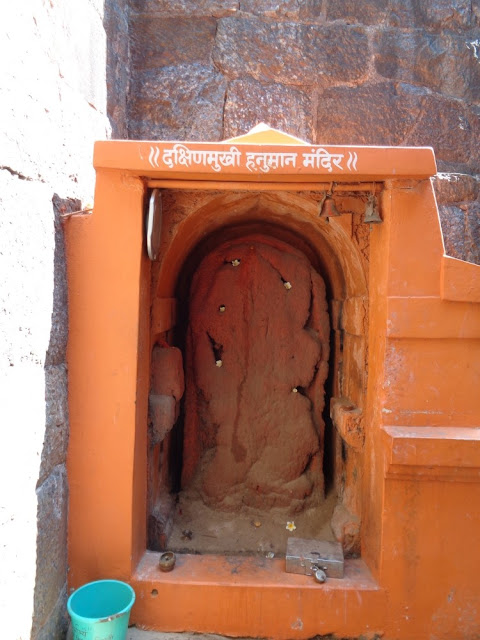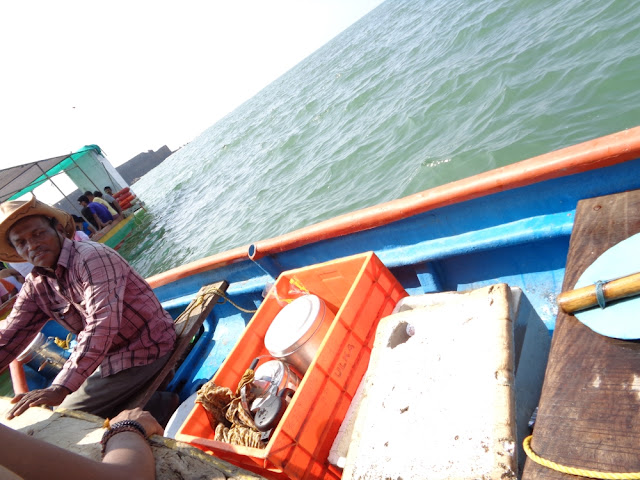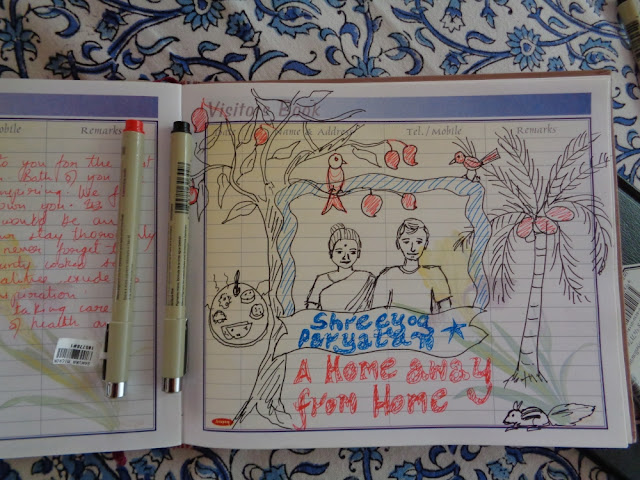Last Sunday, the Times Of India supplement, Times Life, carried an article on ‘Rustication’ or rustic vacations that urban dwellers are
increasingly searching for. I am no different. Having been born and brought up
in the Maximum City, Mumbai, I have discovered that my heart lies in rustic
India, in the beauty of the small, unspoilt villages and mountains, more
specifically. There is something so heart warming about staying in villages and
farms, breathing the pure air, eating food fresh from the farm and the pristine
surroundings. Here’s a round-up of some of the village stays I've experienced
and each one has been memorable. Of course there are more to come. Maybe, I’ll
do part two on village stays sometime.
I've listed these in no particular order, although I've
started with places closer to home.
 |
| In the alpine pastures in Spiti. |
Velas: I visited Velas in February this year to see the hatching of the endangered Olive Ridley turtles. I stayed at Amol Soman’s spicefarm. The sea, sand, turtles, climbing mango trees, lip smacking Konkani food
and lush spice farm made this a memorable experience. The rooms are no-frill,
very basic, since Velas is relatively new to hosting people from the cities.
But to make up for that is the sea (which I had all to myself when I visited),
just a ten minute walk from the home-stay, the verdant spice farm and the
relaxed pace of village life, which has not yet become touristy. Room tariff is
Rs 700 including food and accommodation if you go as a couple or Rs 1000 only
for the stay if you travel solo.
 |
| New born Olive Ridley turtles in Velas. |
 |
| I had the whole Velas beach to myself. |
 |
| Amol Soman's spice farm. |
 |
| Lunch under a mango tree. The taste increased manifold :-) |
 |
| A raw cashew nut. |
Shreeyog Paryatan: I had visited this sleepy village in
Sindhudurg with my husband in January 2015. It was a road trip, passing through
sugarcane fields, vendors selling heaps of the fiery Kolhapuri chilies on the
road side and passing through the bumpy roads on the ghats. The home-stay is
run by the elderly Kadams who will treat you like their own family member. Mrs.
Kadam is an excellent cook and even allows you to decide what you want to eat
for the next meal and cooks accordingly. 25 kms away is the peaceful and
non-touristy Tarkarli beach. Read my review on Tripadvisor. I do not wish you
give out their contact details on this forum. So if you are interested, contact
me. Tariff is Rs 1200 onwards for food and accommodation.
 |
| The vegetable garden in Kadams' house. |
 |
| Fresh farm produce being sold on the way to Tarkarli. |
 |
| Mrs. Kadam is a cook par excellence. |
 |
| The Tarkarli beach only for us. |
Panchgani: I did not stay in Panchgani, but had gone for
strawberry picking in January this year. But if an opportunity presents itself
I would stay on a strawberry farm too, so I’ve listed it under village stays.
Panchgani is the lesser known and non-touristy cousin of Mahabaleshwar, where
people from Mumbai and Pune escape to, during parched summers. Panchgani has
stays for all kinds of budgets. Think of leisurely walks, picking strawberries
in the numerous farms, eating gavran (village) Maharashtrian thali and
basically doing nothing but relax.
 |
| Strawberries by the heaps. |
 |
| Picking strawberries on the farm. |
 |
| Rows of strawberries. |
Rainforest retreat: The Rainforest Retreat or the Mojo Plantation is situated in a village called Gaalibeedu, around 10 kms from
Madikeri, in Karnataka. I had volunteered for vanilla hand-pollination and also
did a wall-art in one of the cottages depicting the local bio-diversity. The 25
acres of the entirely organic plantation grows coffee, vanilla, cardamom,
pepper and fruits like pineapple (the best I’ve ever had), papaya, bananas,
etc. The owners Sujata and Anurag Goel will make you feel at home, talk about
Nature and bio-diversity with such passion that you are bound to leave from
there with more knowledge about the environment and be more awed by Nature’s
intelligence. The staff is extremely sweet and courteous. They invited me to
their home for coffee in the wee hours of the morning, since I was to leave at
6 am. Tariff starts from Rs 2000 onwards. Website: http://www.rainforestours.com/
 |
| Inside the Rainforest Retreat. |
 |
| Misty mornings with the song of the birds. |
 |
| Food was delicious to say the least. |
 |
| Ravi, one of the staff who was extremely courteous and extremely knowledgeable about the flora and fauna of the region. |
 |
| This cutie pie of a calf took fancy to my bag and wanted to eat it. A refreshing change from the boring grass, you see! |
Sullia: A friend had invited us to his brother’s wedding.
The venue turned out to be a 100 acre organic family farm. With sections
devoted to swaying coconut trees, towering areca nut trees, square paddy
fields, the farm is a peninsula of sorts, surrounded by a river on 3 sides,
making the soil rich and fertile. The highlight was seeing and eating the flesh
of a cocoa pod, drinking water from a well (ah, so sweet) and gathering
arecanuts which freshly plucked by the
dexterous tree climber. The wedding was completely, what we urban people would
call, eco-friendly, though for them it’s a way of life and they make no deal
about it! This is a friend’s farm which we were fortunate to visit and stay in,
so it’s not for visitors :-)
 |
| Inside the farm. |
 |
| See how the decoration is entirely made with leaves, fruit and flowers. |
 |
| Eating a cocoa pod. |
 |
| Fresh okra. |
Bhujodi: There was no farm here, but the warmth and love of
my hosts at Bhujodi village, where I painted a wall, made this a wonderful
experience. The simplicity and down-to-earth nature of these award winning
handloom artists, Vankar Dayabhai Ala, his son, Ashok bhai and family makes me
want to go back and visit them again sometime. I was kept well hydrated with
copious quantities of buttermilk to beat the heat, simple, scrumptious rustic
food grown on their farm (which I couldn’t visit), and stories and anecdotes from
their lives as artisans. A bonus was watching the entire process of weaving apiece of cloth as the artisans hummed and sang Kabir bhajans. Since I was painting the wall outside theirhouse, they hosted me.
 |
| A cow staring at me in Bhujodi. |
 |
| Ashok Bhai posing in front of my wall art. |
 |
| Homely food at Ashok Bhai's house. |
Kukma: This was another village where I stayed during my
Kutch trip. I was put up in a rustic-chic guest house at KHAMIR, an
organization that promotes Kutchi handicrafts, and excellently so. I used to
wake up before sunrise, grab some masala chai in an earthen cup (kulhad) and
walk around the campus being amused and entertained by birds chirping on a high
decibel, getting ready to fly off in different directions for food and admiring
the gorgeous sunrise on the barren landscape with sparse trees. I painted a
wall here too. See the pictures here. The food is simple and delicious and the
staff is very helpful. The buildings are made entirely out mud, which keeps the
interiors cool in the desert summer and the décor is simple yet elegant. They
also arrange for cultural tours in Kutch. Tariff starts at Rs 750.
 |
| The simple yet elegant guest house at Khamir. |
 |
| Cups of masala chai over sunrise. |
Spiti: Well, in trans-Himalayan Spiti, you will be
spoilt for choice when it comes to village stays, because except Kaza, the
small town, there are only villages everywhere. I stayed at 5 different villages in Spiti. In Langza, I stayed the longest, volunteering in my host’s
green peas farm. The job mainly involved weeding. Also helped with some
cooking. Then I went to Komic, the highest inhabited village in Asia at the
height of 5150 meters above sea level. In 2013, when I had visited there were
only 13 houses and the total population of the village was 32 people. Next was
Demul, Lhalung and then Tabo. Spiti is spectacularly beautiful from any
village, so take your pick. Many backpackers and trekkers just walk up to a village, knock on a
door and ask to stay. Home-stays charge from Rs 150 to 300 for food and
accommodation. The toilets are dry compost, owing to the dry, arid land and
fragile ecosystem. The people are unbelievably kind and simple, because they
have not yet been corrupted by people outside, but that may change soon with
the promotion of tourism.
 |
| The entrance to Spiti. |
 |
| That's me pulling outs weeds on the farm. |
 |
| Spiti has many monasteries, their bright, lively colours contrasting with the browns and greys of the arid landscape. |
 |
| The highest inhabited village, Komic, as seen from the Komic monastery. |
Ruhil Dhar and Kharapthar: I wanted to volunteer for apple harvesting last year so I visited a friend’s apple orchard in Himachal Pradesh,
which his family has been managing for many generations. Both are remote
villages, so you may not have heard of it. The work was hard for a city girl
like me, but I managed to put in 5 hours of work everyday. The workers taught
me how to climb trees, balance myself on slender branches, pluck the apples,
without destroying the buds, collect them in the bag hung on my shoulder/neck
and pass it down to the person standing below, successfully, without falling
down. I enjoyed every bit of it. That together with the scrumptious, lesserknown traditional Himachali dishes like siddu, mash ke vade, etc made by my
friend’s loving grandmother and served with liberal amounts of ghee, had me
return with lovely memories.
 |
| The beautiful surroundings at Kharapathar. |
 |
| Walking through the clouds and fog. |
 |
| A fully laden apple tree. |
 |
| Variety of Himchali/Pahari delicacies. |
There are so many more villages to visit in so many other
states in India, I've barely scratched the surface. Hope to visit many more
soon. My aim is to visit at least one village in each state :-)
If you have enjoyed reading this post, you may subscribe to new posts updates via email. Enter your email id in the 'Follow by email' on the right hand side panel.
Also follow my posts on Facebook.

































